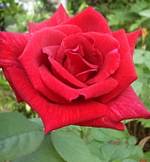making compost
planting annuals
growing flowers
starting a flower garden
Plant Doctor Blog Going Green
Starting a Garden
Lawn Care
Spring Bulbs
Roses
Garden Books
Tools & Acc.
Growing Roses for Beginners
Starting off Right
Selection. When choosing roses, select varieties that are adapted to your growing region. If specific diseases such as black spot are known to be a problem in your region, choose disease-resistant varieties.
Location.Roses require a location that's sunny at least six hours a day, preferablely more. Ideally, the location should provide good air circulation and receive morning sun to help dry off leaves early in the day, which will help minimize disease problems. Roses are best planted in the spring or early fall. (More on Video)
Soil preparation.Once you have outlined the shape of the rose bed, it's time to improve the soil--before planting the roses. Because roses are rather finicky about soil, it's a good idea to have your soil tested. Most university extension services will do this for a small charge. Once the soil analysis is complete, you will know exactly what should be added to the soil and in what amount. This is not the time for skimping. Any extra effort you put into advance preparation will pay off in superior results for years to come.

Care.Standard care includes watering, fertilizing, and pruning. Roses need regular applications of water for top production of flowers. It makes no difference whether the water comes from a hose or from rain. Just make sure the roses receive enough water to moisten the soil to a depth of 18 inches every week during the growing season. The easiest way to check this is with a long screwdriver or stiff piece of wire, such as a straightened-out coat hanger. Either device will be easy to push through moist soil, more difficult once it hits dry soil. In arid summer climates, consider watering your roses with a drip system that is connected to a timer, this will conserve water without allowing the plant to dry out.
At least two applications of fertilizer should be made, once when new growth first starts in the spring and again in midseason. Favor non-burning, natural formulations that feed the soil as well as the plant, such as manure tea.
Managing Pests
Vigorously growing roses will be far less susceptible to attack from
pests and diseases than those that are struggling. However, roses are
susceptible to attack from a variety of pests, so it's helpful to have
some controls at the ready should you find your roses affected.
Disease
Sprays
1. Anti-transpirants, which are normally used
to protect plants from drying out, are believed to work as fungus
controllers by coating the leaves with waxes, plastic polymers, or
silicones, thus preventing fungal spores from entering the
pores in the leaves. Apply just as you would an anti-transpirant;
follow label directions.
2. A mixture of baking soda and horticultural oil is an effective method of controlling powdery mildew. This fungicide also reduces or eliminates black spot to acceptable levels on resistant rose varieties. Use one rounded tablespoon (approximately four teaspoons) of baking soda (sodium bicarbonate) mixed with one tablespoon of horticultural oil per gallon of water, sprayed on a weekly basis or after a heavy rain. Note that baking soda can burn leaves: Apply in early morning and not at all during hottest weather.
3. Sulfur-based fungicides have long been the organic gardener's weapon of choice for battling fungal diseases. However, they can leave residues on the leaves and petals and cannot be used when temperatures exceed 90 degrees F.

4. Whole neem oil is a promising new product for controling black spot, powdery mildew, and rust as well as many insects and mites. (Neem oil comes from the tropical neem tree, Azadirachta indica.)
Insect Pest Sprays
5. Water
. Nothing fancy here, just plain old water. Keeping plants clean helps
prevent problems with spider mites before they start, and a strong
spray of water can knock aphids, spider mites, and other pests off
plants. Spray in the morning, so the leaves will dry quickly.
6. Bt (Bacillus thuringiensis) is a microbial insecticide that kills only moth and butterfly larvae and is harmless to most other insects and animals. However, don't spray throughout the garden or excessively. It won't discriminate between pest caterpillars and those of desirable moths and butterflies.
7. Horticultural oil is a more highly refined version of traditional "dormant" oils applied to leafless trees and shrubs in winter. Horticultural or "summer" oils control a wide variety of rose pests, including rose scale and whitefly. These oils also control soft-bodied pests, such as aphids (and their eggs) and spider mites. Don't use horticultural oils when you expect temperatures to rise above 90oF.
8. I nisecticidal soaps. These specially formulated soaps are a key element in any least toxic pest-control strategy. They are effective against a wide range of mite and insect pests, particularly soft-bodied insects such as aphids, immature scale, leafhoppers, mites, thrips, and whiteflies.
9. Neem oil extracts contain the substance in whole neem oil that is believed to be the most insecticidal. This product provides effective control of insect pests, and, unlike many other pesticides, synthetic and organic, neem is not harmful to most beneficial insects.
| Content provided by NationalGardening.com. |
